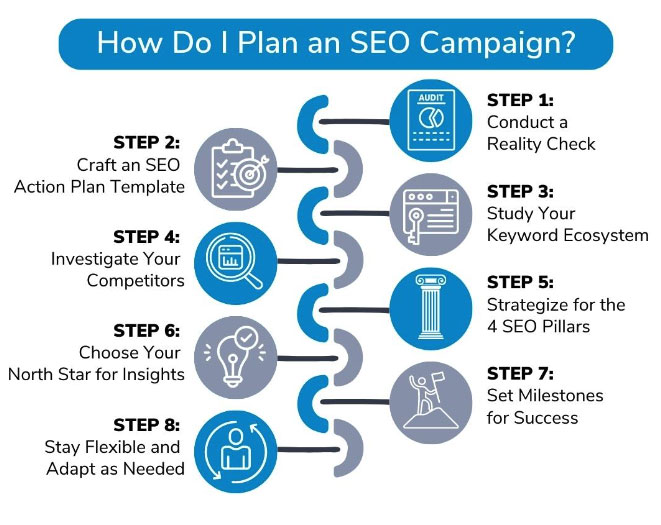Planning Your SEO Campaign: 8 Step Guide
August 17, 2023 •Allison Lemasters

It's no secret that businesses across the globe yearn to harness the power of search engine rankings, capturing the attention of potential customers and driving organic traffic to their virtual doorsteps. But the journey to that coveted digital throne is messy, and finding the perfect SEO content tool or crafting a successful content SEO strategy can feel like an elusive quest.
So, what should be included in an SEO plan? To make all the mud a bit clearer, we’ll break down the key steps of planning a campaign below. And don’t worry—even though 71% of businesses nowadays have a website, our society conducts 5,900,000 searches per minute. If you follow these SEO planning steps below, the right people are bound to find you.

Step 1: Conduct a Reality Check
An effective SEO strategy in digital marketing should start with a website audit. Take a hard look at your website’s current state, identify strengths and weaknesses, and uncover any lurking glitches that might be scaring away potential customers. Ask yourself questions like:
- Is my website content helpful and engaging with clear calls to action?
- How fast are my webpages loading?
- Are my URLs uncomplicated and straightforward?
- Do I have catchy titles and headers throughout my website?
- Does my internal linking structure make sense and follow a logical flow?
- How is my website’s mobile experience?
- Is my website easy to navigate?
- Do I have accessibility features like alt text and image descriptions?
Make notes of any areas that need a little TLC, and use these insights to guide your plan in the following steps.
Step 2: Craft an SEO Action Plan Template
This step is where you ask yourself, “What does an SEO strategy look like for my organization and website?” The blueprint you create will serve as your guide, outlining the tasks, timelines, and responsible parties. Because SEO involves continuous maintenance over time, create a reusable SEO plan template to save time and effort in future campaigns.
Start with prioritizing each issue from your website audit, designating high and low impact as well as short- and long-term projects. For example, say your website loads at more of a turtle’s pace (which is anything slower than three seconds in the cyberworld). Improving page load time will have a high impact in this instance—visitors have the patience of a squirrel on caffeine, and we all tend to scurry off to the next result if a site takes too long to load. But reducing load times is definitely a long-term task, requiring image and file compression, caching mechanisms, code optimization, and much more.
While some issues demand time and effort, others provide quick wins with varying impact levels. Go after these wins while still pursuing long-term optimization. By striking this balance, you’ll pave the way for a successful SEO campaign.
Step 3: Study Your Keyword Ecosystem
Keywords are the secret spices of the SEO world, helping search engines understand what your website is all about. Say you’re running a yoga studio; you may use keywords like “beginner yoga classes,” “yoga for stress relief,” or “best yoga poses for flexibility.” Strategically sprinkling keywords like these throughout your website serves as a signal to search engines, communicating the core mission and relevance of your website.
A few ways you can use your chosen keywords include:
- Incorporating keywords in page titles, headings, and subheadings.
- Utilizing keywords in meta descriptions.
- Integrating keywords in content.
- Letting keywords guide content.
- Hyperlinking strategically on keywords.
If you have designed your website around keywords, then make a list of what you already rank for. You will likely find opportunities for easy wins by doing this—perhaps you have a page ranking 10th that could easily move up rankings with a few upgrades. If you’re newer to keyword SEO, then you need to research what keywords to use that best support your goals and speak to your target audience.
Thankfully, DemandJump can help with all of the above. From the beginnings of keyword research to keyword tracking, DemandJump provides comprehensive tools and insights to optimize your keyword strategy using Pillar-Based Marketing (PBM). We also support competitor analysis, which brings us to the next step…
Step 4: Investigate Your Competitors
The battle for the top search result positions is never won without intel on your competition. Scout their web presence, observe their tactics, and pinpoint their strengths and weaknesses as you did your own. Your goal from this step is simple: identify what your competitors are doing right, and then find innovative ways to outsmart and outshine them.
To walk you through how this might work, imagine you run a Software-as-a-Service (SaaS) company that provides human resources solutions. You note that your biggest competitor is outranking you for the phrase “human resources management software.” Start by checking out that high-ranking web page specifically, and then move through the rest of their website. Pose the same questions you asked during your own website audit and compare their strengths to your weaknesses. This exercise will reveal certain obstacles that prevent you from conquering that coveted top position.
You can easily track the keyword rankings and positions of multiple competitors by using DemandJump. With just a few clicks, you’ll have a whole dashboard of insightful information, including direct links to the specific content pieces in question. This feature proves invaluable in keeping tabs on your competitors’ activities, ensuring that you don't miss any crucial developments.
Step 5: Strategize for the 4 SEO Pillars
As you plan your SEO campaign, it’s essential to focus on the four pillars of SEO: on-page, off-page, technical, and local. These pillars support your website’s SEO foundation in the following ways:
- On-Page Pillar: Optimize your on-page elements by fine-tuning meta tags, headings, and URLs with targeted keywords. You must also craft compelling content and enhance your user experience through intuitive navigation and engaging design.
- Off-Page Pillar: Build a strong off-page SEO strategy by engaging in influencer collaborations, participating in industry forums, and leveraging social media to amplify your brand and drive traffic.
- Technical Pillar: Focus on the technical aspects of your website, like optimizing site speed, implementing proper URL structures, ensuring mobile responsiveness, and securing your website with HTTPS to establish trust and enhance security.
- Local Pillar: Use local SEO to target location-based searches and connect with your local audience. This involves optimizing your Google My Business profile, acquiring local citations and backlinks, and creating locally-focused content that resonates with your target market.
Step 6: Choose Your North Star for Insights
Measuring and analyzing progress is essential in any SEO campaign to understand its effectiveness and make data-driven decisions. When choosing a way to measure and analyze progress, it’s important to identify clear metrics that align with your campaign goals. These could be an increase in organic search traffic, higher keyword rankings, improved conversion rates, or other key performance indicators (KPIs) that directly impact your business objectives. By focusing on a specific metric, you can track progress over time, identify trends, and make informed adjustments to optimize your SEO efforts.
Along with having key metrics to track, you also need a platform or tool that measures your progress. The DemandJump platform is an excellent example of this, as you can monitor content performance, keyword rankings and trends, and so much more, all in one convenient place.
Step 7: Set Milestones for Success
Similar to Rome, you can’t build an SEO empire in a day. It’s going to take some time and hard work, which is why you set specific targets and celebrate milestones along the way. Some examples of milestones could include:
- Achieving a certain percentage increase in organic search traffic within a specific timeframe.
- Attaining a specific ranking position for targeted keywords on search engine results pages (SERPs).
- Increasing the average time spent on your site and reducing your bounce rate.
- Receiving a specific number of inquiries or leads through organic search.
- Improving conversion rates for targeted landing pages or key actions on your website.
- Attaining a certain number of positive customer reviews or ratings.
Setting milestones provides clear objectives and helps track progress towards achieving broader SEO goals. Celebrating these milestones not only boosts morale but also keeps teams motivated and focused on driving continuous improvement.
Step 8: Stay Flexible and Adapt as Needed
In the ever-changing realm of SEO trends, flexibility is key. Keep an eye on the horizon for algorithm updates, shifts in user behavior, and emerging trends. Be ready to modify your strategies, adapt your content, and pivot when necessary. The ability to navigate the stormy SEO seas and make adjustments on the fly will ensure your campaign’s success.

What Makes a Good SEO Campaign?
By incorporating the steps above and leveraging the insights provided by DemandJump’s comprehensive platform, you can develop a solid SEO strategy, make data-driven decisions, and achieve your campaign goals effectively. Why not try DemandJump for free and see the difference it can make in your SEO campaigns? Take the first step towards dominating the search engine rankings and driving organic traffic to your website—click below to get started!
Featured Articles
Categories
- Attribution Tracking (13)
- Channel Optimization (11)
- Consumer Insights (68)
- Content Marketing (251)
- Data Science (8)
- Digital Marketing (6)
- Digital Transformation (26)
- Enterprise (10)
- Lead Generation (14)
- Market Intelligence (8)
- Marketing Analytics (39)
- Marketing Attribution (57)
- Marketing Management (153)
- Marketing Operations (86)
- Organic Search (222)
- Paid Search (52)
- Pillar-Based Marketing (63)
- Programmatic Advertising (9)
- SaaS Content (14)
- SaaS Marketing (29)
- Search Marketing (111)
- SEO Keyword Research (28)
- SEO Pillar (18)
- SEO Strategy (46)
- SMB (5)
- Website Content (12)


